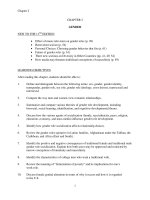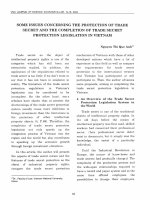Fisher when money was in fashion; henry goldman, goldman sachs, and the founding of wall street (2010)
Bạn đang xem bản rút gọn của tài liệu. Xem và tải ngay bản đầy đủ của tài liệu tại đây (1.82 MB, 287 trang )
When Money
Was in
Fashion
This page intentionally left blank
When Money
Was in
Fashion
HENRY GOLDMAN,
GOLDMAN SACHS, AND THE
F O U N D I N G O F WA L L S T R E E T
JUNE BRETON FISHER
Photograph of the original Goldman Sachs building is reproduced
courtesy of Goldman Sachs
Photograph of the Goldman and Sachs family gathering in Elberon,
New Jersey is provided courtesy of Goldman Sachs
Photographs of Goldman family members are provided courtesy of the
author
WHEN MONEY WAS IN FASHION
Copyright © June Breton Fisher, 2010.
All rights reserved.
First published in 2010 by
PALGRAVE MACMILLAN™
175 Fifth Avenue, New York, N.Y. 10010 and
Houndmills, Basingstoke, Hampshire, England RG21 6XS.
Companies and representatives throughout the world.
PALGRAVE MACMILLAN is the global academic imprint of the
Palgrave Macmillan division of St. Martin’s Press, LLC and of Palgrave
Macmillan Ltd. Macmillan® is a registered trademark in the United
States, United Kingdom and other countries. Palgrave is a registered
trademark in the European Union and other countries.
ISBN-13: 978-0-230-61750-6
Library of Congress Cataloging-in-Publication Data is available from
the Library of Congress.
A catalogue record of the book is available from the British Library.
Design by Letra Libre
First edition: May 2010
10 9 8 7 6 5 4 3 2 1
Printed in the United States of America.
Contents
Acknowledgments
vii
Preface 1
One
Against All Odds 5
Two
Banking in “The Swamp” 25
Three
The Goldmans and the Sachses 43
Four
Going Public 67
Five
War in the Boardroom 89
_ V _
Six
Phoenix Rising 119
Seven
The Fine Art of Collecting Fine Art 161
Eight
Bull Point Camp 201
Nine
A Child Prodigy 225
Ten
End of the Line 245
Afterword 263
Notes 269
Index 274
_ VI _
Acknowledgments
A
number of people have contributed to the creation of this book, and I owe each and every
one a vote of thanks. I am especially grateful to
my friend Dan Alef, without whose encouragement and interest I
would never have started—or finished—the book; Victoria Skurnick,
my wonderful agent, who gave me faith in myself and wrote such a
great pitch on my behalf; my publisher and editor, Airié Stuart, whose
advice transformed an assortment of rambling verbal snapshots into a
meaningful portrait of an extraordinary man unknown by the public;
the ever-patient Marie Ostby and Leah Carroll, for fielding unending
questions about the minutiae of the publishing world; David Rotstein,
who designed the wonderful jacket; and Kathleen Laman, along with
Ardis Parshall, for their assistance in typing the manuscript.
Peter Thompson and Ed Canaday, of Goldman Sachs, gave me
invaluable access to the archives at Goldman Sachs.
Mayor Kurt Mauer, of Trappstadt, Germany, and his friends
Elizabeth Bohrer and Michael B shared their extensive knowledge
_ VII _
When Money Was in Fashion
of the Goldman and Sachs family backgrounds, genealogy, and early
history.
Arthur and Mary Sachs filled in the cracks.
The following people were also invaluable in my research: Mark
Henderson and Kate Ralston of the Getty Research Institute; Charis
Shafer and her staff at the Oral Research Department at Columbia
University; Charles Griefenstein of the American Philosophical Society; Anna Lee Pauls and Charles Greene of Princeton University;
Barbara Wolff of the Hebrew University in Jerusalem, Israel; Mary
Hotaling of the Adirondack Historical Society, who made available
material on Albert Einstein, Joseph Duveen, Yehudi Menuhin, Max
Born, and members of the Sachs family who are long since gone.
Barbara Cohen and her daughter, Marcia, shared family photographs from their private collection.
Wolfgang Grahl provided excellent translations of correspondence from Germany.
The staff of the Montecito, California, Public Library were unfailingly helpful in tracking down the innumerable books that I used
in my research.
And, of course, my daughter, journalist Tracy Breton, for her research assistance.
And last but not least, I need to thank my mother, who kept the
family photographs in pristine order and remembered the stories.
_ VIII _
Preface
_ 1 _
This page intentionally left blank
E
ver since my fourth-grade teacher spun tales of the
pharaohs and the treasures buried with them inside
the pyramids, I have harbored a wild desire to dig
and discover secrets of my own. They say archeology is in your
blood—my great-aunt Hetty was a famed Mesopotamiast who participated in significant excavations in Greece and Turkey in the
1920s and 30s and was the first woman fellow in the humanities department of the Institute for Advanced Study. But I never saw Egypt
or the land of the Iliad until I was well into middle age, and by then
my intellectual curiosity had become more focused on a subject
closer to my real-time life, my grandfather Henry Goldman, the
iconic, innovative co-leader of the great firm Goldman Sachs, and
America’s first investment banker.
The world was familiar by then with his many and varied exploits, although he had made every effort to maintain anonymity
while achieving his goals. I, a virtual fly on the wall, young and precocious, had not only known him personally, but had also been witness to his relationships with a fascinating mix of people, many of
whom were changing the world in one way or another. I now wanted
to peel back the layers of secrecy swaddling his persona and show
him to the world.
And so began a three-year journey that has taken me to
Philadelphia, New York, Berlin, Dresden, St. Moritz, Paris, BadenBaden, and Trappstadt, the little Bavarian village where it all began.
_ 3 _
When Money Was in Fashion
Henry Goldman
Although a few of the incidents contained in my story are simply
based on educated hearsay, notably the link-up of Marcus Goldman and Joseph Sachs in Philadelphia, all the events and characters are real and, for the most part, speak for themselves.
_ 4 _
CHAPTER ONE
Against All Odds
“Men can learn from the past, and I’ve been shocked how little some
of the younger executives in the present firm know about its origins.
They don’t even know that my grandfather whose picture is on the
wall there founded the firm.”
—Walter Sachs, senior partner of Goldman Sachs, 19281
_ 5 _
This page intentionally left blank
M
y grandfather, Henry Goldman, was the
son of a poor German immigrant named
Marcus Goldmann who was born in
1821 in Trappstadt, one of a number of small villages that dot the
rolling green wheat fields and dense forests of the Bavarian countryside. Marcus was the eldest child of Wolf Goldmann, a farmer
and cattle dealer, who was married to a young woman by the name
of Bella Katz Oberbrunner from the neighboring town of Zeil am
Main. She had already had five children by her first husband,
Samuel, when he died at the age of thirty-seven.
Trappstadt, the Bavarian village where Marcus was born, 1840s
_ 7 _
When Money Was in Fashion
The family name had not always been Goldmann. According to
the decree of the Catholic diocese of nearby Würzburg, which had
ruled the region since the eleventh century, Jews did not have surnames and were known only by their given names and those of their
fathers, and thus Wolf’s father originally bore the name of Jonathan
Marx, or more correctly, “Jonathan son of Marx.” But in 1811, at
the age of fifty-eight, when the Church revised its mandates and required the Jewish population to assume family names, Jonathan
chose Goldmann, identifying it with the wealth and respected reputation of the elder citizen who officiated at his son Wolf’s wedding.
Wolf was their first child, a restless, ambitious young man with
a thirst for education who found the city walls of his hometown far
too confining. The family home was located just around the corner
from the local schoolhouse, and when he finished helping his father
in the barnyard and the garden, Wolf would sneak into the back of
the classroom and absorb as much as he could of the day’s lessons
in bookkeeping, reading, and history.
Although surrounded by vineyards and already well regarded as
a center for breweries, Zeil offered virtually no opportunities for
Jews to earn an independent living. Restrictive municipal laws, in
fact, forbade Jews from voting, marrying, or having children, and so
Wolf plotted from an early age to leave his family homestead and
move closer to Bamberg, a larger, more progressive city sixteen miles
away. However, in 1813 the Catholic diocese had imposed quotas on
the number of Jews allowed to settle in each of the minuscule villages
of the region, and to ensure compliance charged “protection money”
from those who were granted residence permits. These measures vir-
_ 8 _
Against All Odds
tually eliminated the possibility of a Jew’s relocating to another
township unless he replaced a dead man on the census rolls. Wolf
started to haunt the record hall in Würzburg, which listed the names
of Jews who had recently been interred and the villages in which
they had resided. After many months of fruitless checking, he spotted the name of Samuel Oberbrunner, a young cattle dealer from the
market town of Trappstadt, who had passed away shortly after the
first of the year. He was survived by a wife, Ella, and five children
ranging from four to eleven years of age. Investigating further, Wolf
found that the young widow had not been left enough money to hire
someone who could help tend the livestock that provided the family’s livelihood. Recognizing that he and Ella had compatible needs,
Wolf presented himself at the kitchen door of her house, which was
simply identified as Number 16, and suggested that he work for her
as a hired hand in exchange for his room and board.
The couple was married six months later in Sternberg, where
Ella had grown up, as there was no synagogue in Trappstadt. Who
knows whether it was a marriage of love or convenience or a combination of the two? They led a contented family life for forty years
and had five more children, four of whom survived. Mark, the eldest, was born in 1822, Samuel (who died as an infant) two years
later, and then another boy, Simon, and two girls, Bella and Regina.
The family moved to a larger home near the town cemetery and the
synagogue, where there was a growing colony of fifty-three Jews in
residence, and the family cattle business thrived.
His stepsisters all made a fuss over Mark—after all, there were
five of them, and for years he was the only boy! But he remained
_ 9 _
When Money Was in Fashion
sweet natured and obedient, and was never known to give his parents any trouble. He loved school and was a good student, particularly adept at mathematics. His brother Simon, four years his junior,
was his total antithesis: mischievous, volatile, doing his daily chores
only after persistent nagging. Nevertheless, the boys were close to
each other and looked forward to the monthly market days in the
village when they helped their father sell his cattle. People from all
the surrounding villages streamed into the main square for the occasion, and the town had the feeling of a big, jolly party.
Every spring their father took them to the larger district market
in Bamberg, nine miles away. They rose while it was still dark to
herd the cattle up and down rutted dirt paths that meandered
through the pastoral terrain. Simon was sometimes inclined to whine
and complain, but Papa would shush him with fanciful tales about
the glamorous lives of the Baron and Baroness von Henneberg, who
governed the area, and Mark would sing folk tunes he had learned
from Hungarian gypsies passing through town. Any thoughts of
being tired or having sore feet vanished once they reached the outskirts of the city.
Bamberg rose like a fairyland between the river Regnitz and a
canal that was crossed by several wooden bridges. A lock and a weir,
situated below the tall frescoed town hall, took pride of place in the
middle of town. Half-timbered and baroque houses in ice cream
shades of peach and sandstone and pistachio green, all with red tile
roofs, lined the winding narrow cobblestone streets—so narrow that
the boys sometimes spotted the fire brigade answering alarms on bicycles rather than horse-drawn wagons. Beautiful stone and plaster
_ 10 _
Against All Odds
representations of saints and angels decorated the outside walls of
many houses they passed. And rising above everything was the
cathedral, with its spires and impressive stained-glass windows.
Once in a while the boys would peek inside and gawk at the likeness
of the city’s founder astride his horse, which had been carved into the
wall of the nave many centuries earlier.
The market was held at the Maximiliansplatz, the largest square
in the city. Every imaginable fruit and vegetable was sold there—fat
white asparagus and luscious strawberries, and mushrooms, potatoes, cauliflower, and cabbages harvested in fall. Around the corner,
overlooked by the Gabelmann, or Neptune Fountain, there was a
large flower market where ladies from the surrounding manor
houses sent their servants to fill baskets with roses, lilies, and marguerites. Downstream from the town hall and the Benedictine
monastery, in “Little Venice,” colorful half-timbered fishermen’s
houses with neat little gardens and tiny balconies were lined up like
a stage set facing the river. The cattle market and the municipal
slaughterhouse were located nearby.
While Wolf negotiated the best prices for his cattle—and he was
known to be a master at bartering—the two boys skipped stones on
the river and watched the local toughs competing in rowing races
and jousting as they balanced in canoes. At the closing bell, Papa
would drop in to one of the many beer kellers on the street—there
were sixty-five of them within the city, some over a hundred years
old—for a pint and a pipe and to gossip with other farmers who had
come to town for market day. The conversation was always spirited
and spiked with acrimony about the peasants’ lack of representation
_ 11 _
When Money Was in Fashion
in the government, the economic havoc wreaked by endless wars
among Germany’s many feudal states, the punishing taxes from
which only the rich seemed to benefit. And, not least, the “blood
money” extracted by the government to obtain papers allowing those
from the less privileged classes to emigrate in search of a better life.
The Goldmann children were devoted to one another, the older
girls taking care of the little ones and assisting with the household
chores while the boys tended the animals and helped their father in
the fields. Once they reached the age of six, both boys and girls attended a “mixed” school for Christian and Jewish children and
were taught history, geography, simple arithmetic, and a smattering of English. Wolf was especially proud of Mark, who, at the age
of sixteen, had been encouraged by the schoolmaster to make periodic trips to the Würzburg synagogue, where the rabbi offered
more advanced classes to outstanding students. It was there that
Mark made the acquaintance of Joseph Sachs, the nineteen-yearold son of a poor saddle maker. Joseph had determined at an early
age that he wanted to make a career of teaching school. The two
young men became fast friends, never dreaming that their futures
would be entwined for more than a century in a land they had yet
to see.
At the time, Joseph was boarding in the home of a rich
Würzburg goldsmith by the name of Baer, where he had been engaged to tutor the young lady of the house, Sophia. Ignoring her parents’ staunch disapproval, she developed a crush on her teacher, and
a storybook romance developed. They secretly pooled Joseph’s meager savings with the jewelry Sophia had received from her parents
_ 12 _
Against All Odds
since her birth and eloped one night to the port of Hamburg. There
they stayed at the home of one of her cousins and were married several weeks later. Then, with little more than his tutoring credentials
in his battered suitcase, Joseph set sail for Philadelphia, first circling
South America with his plucky and adoring bride at his side. The
journey lasted six weeks.
It had become increasingly apparent that there was no future for
young Jewish men in Germany. Their station in society was lower
than that of the Negro in pre–Civil War America. Rumblings of uprisings against the monarchy were becoming louder and increasingly
passionate, jobs were almost nonexistent, and a year-long drought
had resulted in poor harvests and a devastating famine. In addition,
the likelihood of all able-bodied men being conscripted for military
service in support of governments reluctant to recognize their basic
rights seemed probable. Wolf reluctantly concluded it was time for
his eldest son, who had just turned twenty-seven, to seek a new start
in the United States.
The Bamberg newspaper had run stories almost every day about
the grand opportunities available to newcomers in America, the
warm welcome they were receiving, the fairness and freedom of a
democratic society. In fact, a recent article had told of an orphan
boy named Levi Strauss from a nearby village who had left the Old
World and peddled fabrics from a backpack when he got off the
boat. Soon afterward, he made a fortune sewing work pants for gold
prospectors heading out west. As Mark deliberated and demurred,
concerned that his parents would find running the farm without his
help too heavy a load, twenty-three-year-old Simon, entranced with
_ 13 _
When Money Was in Fashion
the vision of gold lying on the streets of California, impulsively volunteered to keep him company.
On the eve of Mark and Simon’s departure in 1848, Ella baked
the family’s favorite apple cake and Wolf gave both of his sons his
blessings and 150 gulden to tide them over until they were settled.
There were no regrets, no long-drawn-out farewells. In the morning, Mark and Simon registered for exit papers with the town clerk
at the village Rathaus and paid a hefty “Jewish tax” on top of the
$50 charge for train tickets to Bremerhaven and passage on the
steamship Miles to London. There they would board the Margaret
Evans, bound for Philadelphia, the City of Brotherly Love, which
was surrounded by verdant farmland and offered a myriad of employment opportunities to immigrants. It was said to have a sizable
German population and was hospitable to Christians, Muslims, and
Jews alike.
The Miles was packed to the gunwales with German émigrés
when the halyards were set free and she drew away from the dock.
An unexpectedly large increase in the German population over the
past few years had fostered a move to stimulate emigration with cash
rewards, which were freely disbursed among doctors, lawyers, musicians, teachers, and artists. All the proletariat, in fact, except those
of the Jewish faith. Unacceptable as they may have been, they alone
were required to buy their way out.
As the ship’s white sails unfurled and she drew out of the harbor,
the passengers gathered on deck to have a last glimpse of their homeland and sang a sad song of farewell. “A proud ship goes lonely,”
went the refrain, “taking our German brothers away . . . to America.
_ 14 _
Against All Odds
Poor Germany, do you want to banish us to live the rest of our lives
and die in America? We have nowhere else to go and our choice
would be to stay. Don’t forget us. We shall return someday.”
It was an extremely rough night crossing the Channel, and the
brothers spent most of the voyage clinging to the railing on the upper
deck. London showed them few of her charms, and they spent the
early hours of the morning searching the port through a pea soup fog
for the Margaret Evans. When at last they signed on board, they
were assigned quarters measuring six by six feet, which they were to
share with two other émigrés, a British machinist and a brewmaster
from Munich, who was planning to join the gold rush and make his
fortune in California. The brewmaster was a barrel-chested fellow,
tall and fair with a wispy mustache and a booming voice, and he
told tall tales he had overheard of the mobs rushing to find gold in
California and the dark-eyed señoritas waiting with open arms in
every doorway. Simon was immediately smitten, and vowed to follow him on the first available wagon train.
Conditions aboard ship were rudimentary at best. There was
one toilet for every fifty people, and the drinking water was rank
and bitter. The passengers jostled one another to receive their daily
ration of thin soup, cabbage, and potatoes, and their blood ran cold
seeing little children dying of hunger and exposure on the upper
deck. There were rumors of cholera and dysentery spreading among
the crew below decks. When the ship finally reached shore on September 4, a great shout of relief was heard, and the ragtag band of
passengers, significantly diminished after the two-week ordeal,
pushed and shoved to disembark.
_ 15 _
When Money Was in Fashion
True to his promise, Simon melted into the crowd with his
newfound friend from Munich, giving his brother a friendly punch
on the shoulder. “Come and see me in California!” he cried. “I’ll
have a fine house and horses and a beautiful wife by next year and
you may change your mind and join me.” But Mark concluded
he’d had enough adventure and was ready to settle down to a
quiet, hardworking life in the New World. Simon would eventually
fail in his quest for gold and settle in Sacramento, where he married, had five daughters, and became the owner of a small neighborhood grocery store.
As Mark descended the gangway, the sweet, earthy aroma of
produce in autumn struck him instantly—apples and carrots and
cabbages. And it was no wonder, for the city marketplace was just
a few steps from the harbor. It was noisy and thronged with people:
butchers selling their hogs, girls carrying crates with squawking
chickens, cheese makers, fishermen with their morning’s catch.
Dahlias and sunflowers and zinnias stood in milk pails at the flower
stalls, just like at home. He was surprised to hear so much German
being spoken and was startled by a tap on his shoulder. When he
turned, he was confronted by his old friend Joseph Sachs with his
pretty bride Sophia glowing beside him.
“Well, Mark, this is a surprise!” Joseph said. “I had no idea you
were coming so soon. Have you been promised a job? A place to live?”
Mark, his cardboard suitcase with all his belongings still in
hand, admitted he hadn’t.
“It isn’t so easy,” Joseph continued. “I’ve been without work
since we arrived. But maybe it will be different for you. You haven’t
_ 16 _









